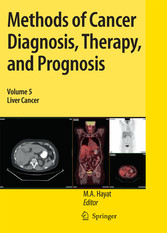Suchen und Finden

Methods of Cancer Diagnosis, Therapy, and Prognosis - Liver Cancer
This volume presents a detailed survey of imaging, multidetector-row computed t- various methodologies related to diagno- ography, helical computed tomography, sis, therapy, and prognosis of liver cancer, ultrasonography, and power Doppler ult- including colorectal liver metastases and sound, for the prognosis and assessment of biliary tract carcinomas, while the already liver cancer treatment (including HCC) and published Volumes 1, 2, 3, and 4 detail liver metastases from colorectal cancer are similar aspects of breast, lung, prostate, discussed in detail, as is the use of radiof- gastrointestinal, and colorectal cancer, quency ablation in hepatic tumors. respectively. Approximately 50% of colorectal cancer Surgical resection is the standard therapy (CRC) patients develop liver metastases for resectable liver disease, resulting in during the course of their disease, and 5-year overall survival rates of 20-40%. more than 50% of patients who die of CRC One the other hand, the median overall have liver metastases at autopsy. Regional survival of patients with unresectable liver lymph node (RLN) involvement in patients metastases does not exceed 18-20 months, with colorectal liver metastases is one with a 5-year survival rate approaching of the worst prognostic factors. Recent zero. In other words, there is virtually no studies indicate that for these patients, long-term survival. Both resectable and combined liver resection and pedicular unresectable liver cancers are discussed lymphadenectomy can be recommended, in this volume. The method of selecting when RLN metastases respond to p- patients for resection of hepatic colorectal operative chemotherapy.
Alle Preise verstehen sich inklusive der gesetzlichen MwSt.










